April 30, 2025
Are you looking to save money on pool heating while keeping your water clean? Thermal blankets might be just what you need! These simple covers float on your pool’s surface, capturing the sun’s warmth and keeping heat from escaping, all while protecting your pool from debris and reducing maintenance.

Key Takeaways
- Temperature boost of up to 7 degrees from solar heating
- Reduces evaporation by up to 95%, saving water
- Cuts chemical usage by 35-60%
- Prevents algae growth by blocking sunlight
- Lasts 3-5 years with proper maintenance
- Available in various thicknesses (200-800 microns)
What Are Pool Thermal Blankets and How Do They Work?
Definition and Basic Functionality
Thermal blankets (also called solar blankets) are specially designed covers that float directly on your pool water. Made from polyethylene with UV inhibitors, these covers feature small bubbles that trap heat and prevent it from escaping. Think of them as a blanket that keeps your pool warm, just like the blanket on your bed keeps you cozy at night.
How Solar/Thermal Blankets Utilize the Sun’s Rays
During daylight hours, thermal blankets capture the sun’s energy and transfer it to your pool water. The bubbles act like tiny magnifying glasses, focusing sunlight and converting it to heat. Dark-colored blankets absorb more heat, while clear ones allow sunlight to penetrate deeper into the water.
The Science Behind Heat Retention and Insulation
The air-filled bubbles create an insulating layer between the cool air and your warm pool water. This physical barrier prevents heat from escaping through evaporation, which is responsible for about 70% of pool heat loss. When placed bubble-side down, the blanket creates a tight seal on the water’s surface, maximizing this insulating effect.
Benefits of Using Thermal Blankets for Your Pool
Temperature Regulation: Heating Pool Water by Up to 7 Degrees
One of the most impressive benefits of swimming pool covers is their ability to naturally heat your pool. Users report temperature increases of up to 7 degrees Celsius—without running expensive heaters! This means you can enjoy your pool earlier in spring and later into autumn.
Heat Retention During Evening and Windy Conditions
Even after sunset, thermal blankets keep working by preventing the heat gained during the day from escaping. This is especially important on windy days when evaporation rates increase dramatically.
Preventing Water Evaporation (Up to 95% Reduction)
Did you know an uncovered pool can lose 2-4 cm of water per week through evaporation? Thermal blankets reduce this water loss by up to 95%, saving thousands of liters of water each season. For pool owners in drought-prone areas, this benefit alone can justify the investment.
Reducing Chemical Usage by 35-60%
With less evaporation, your pool chemicals stay in the water longer instead of evaporating with the water. Most pool owners report using 35-60% fewer chemicals after installing a thermal blanket. At current prices, this could save you hundreds of Rand each season.
Energy Savings and Lower Electricity Costs
If you heat your pool, a thermal blanket can reduce your energy consumption by 50-70%, according to EPA estimates. For a typical pool, this translates to savings of thousands of Rand annually on your electricity bill.
Algae Prevention Through Light Inhibition
Dark-colored thermal blankets like the EnergyGuard GeoBubble prevent sunlight from entering the pool. Without light, algae can’t photosynthesize and grow, resulting in cleaner water with less maintenance.
Types of Thermal Blankets Available
Standard Polyethylene Blankets with UV Inhibitors
The most common type of thermal blanket is made from polyethylene with added UV inhibitors to prevent sun damage. These affordable options provide excellent heat retention and typically last 3-5 years.
Energy Guard GeoBubble Technology
The EnergyGuard GeoBubble represents the next generation of thermal blankets. Its unique bubble shape eliminates weak points found in traditional bubbles, extending the cover’s lifespan by up to 25%. The dark grey top surface and black underside maximize heat absorption while blocking light to prevent algae growth.
Micron Thickness Options (200-800 Microns)
Thermal blankets come in various thicknesses, measured in microns:
- 200-300 microns: Budget options, 1-2 year lifespan
- 400-500 microns: Standard thickness, 3-4 year lifespan
- 600-800 microns: Premium options, 4-5+ year lifespan
Thicker blankets offer better insulation and durability but cost more initially.
Color Variations and Their Impact on Heat Absorption
| Color | Heat Absorption | Light Blocking | Best For |
|---|---|---|---|
| Clear | Medium | Low | Maximum water heating |
| Blue | Medium-High | Medium | Balance of heating and algae prevention |
| Grey/Black | Highest | Highest | Algae prevention and evening heat retention |
Clear Thermal Blankets for Daytime Heating
Clear blankets allow more sunlight to penetrate deeper into your pool, heating the water more effectively during daylight hours. However, they don’t block as much light, so they’re less effective at preventing algae growth.
Choosing the Right Thermal Blanket for Your Pool
Considering Pool Size and Shape
Swimming pool covers for sale come in standard sizes or can be custom-cut to fit your pool’s exact dimensions. For irregularly shaped pools, you’ll want to measure carefully or consider having a cover custom-made.
Material Durability and Lifespan Expectations (3-5 Years)
With proper care, expect your thermal blanket to last:
- Economy models: 1-2 years
- Standard models: 3-4 years
- Premium models: 4-5+ years
Factors affecting lifespan include UV exposure, chemical balance, and how the cover is stored when not in use.
Climate Considerations and Seasonal Usage
Your local climate should influence your choice:
- Hot, sunny climates: Choose darker colors to prevent algae
- Moderate climates: Blue or clear covers work well
- Cooler climates: Clear covers maximize heat gain
Saltwater Pool Compatibility
If you have a saltwater pool, make sure to choose a thermal blanket specifically rated for saltwater use. Salt can degrade standard covers more quickly, but salt-resistant models are available.
Installation and Maintenance Tips
Proper Placement (Bubble Side Down)
Always place your thermal blanket with the bubbles facing down toward the water. This creates the best seal and maximizes heat retention.
Automatic Reel Systems for Easier Handling
For larger pools, consider investing in a swimming pool cover roller system. These devices make it much easier to remove and replace your thermal blanket, encouraging more consistent use.
Trimming for Custom Fitting
Most thermal blankets can be trimmed with ordinary household scissors to fit your pool perfectly. Leave about 5cm of overlap at the edges to account for shrinkage over time.
Maintenance Best Practices
- Rinse with fresh water monthly to remove chemical buildup
- Check for tears or damage regularly
- Keep water chemistry balanced to prevent cover deterioration
- Use a swimming pool safety cover during off-seasons for added protection
Environmental Benefits of Thermal Pool Blankets
Using a thermal blanket isn’t just good for your wallet—it’s good for the planet too! By reducing water evaporation, chemical use, and energy consumption, you’re making a positive environmental impact.
Looking for swimming pool covers near me? Local suppliers can help you find the perfect thermal blanket for your needs while providing expert advice on installation and maintenance.
Conclusion
Thermal blankets are a simple yet effective way to improve your pool’s efficiency. By raising water temperature, reducing evaporation, cutting chemical use, and preventing algae growth, these covers pay for themselves quickly while making pool ownership more enjoyable and environmentally friendly.









